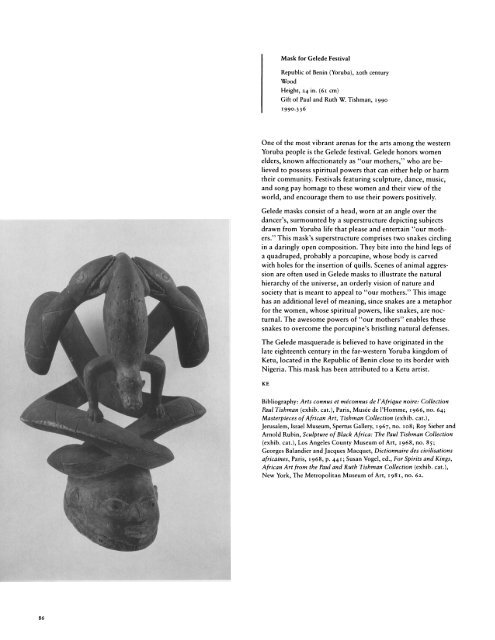The Metropolitan Museum of Art / Bulletin
The Metropolitan Museum of Art / Bulletin
The Metropolitan Museum of Art / Bulletin
You also want an ePaper? Increase the reach of your titles
YUMPU automatically turns print PDFs into web optimized ePapers that Google loves.
Mask for Gelede Festival<br />
Republic <strong>of</strong> Benin (Yoruba), zoth century<br />
Wood<br />
Height, 24 in. (6i cm)<br />
Gift <strong>of</strong> Paul and Ruth W. Tishman, i990<br />
1990.336<br />
One <strong>of</strong> the most vibrant arenas for the arts among the western<br />
Yoruba people is the Gelede festival. Gelede honors women<br />
elders, known affectionately as "our mothers," who are believed<br />
to possess spiritual powers that can either help or harm<br />
their community. Festivals featuring sculpture, dance, music,<br />
and song pay homage to these women and their view <strong>of</strong> the<br />
world, and encourage them to use their powers positively.<br />
Gelede masks consist <strong>of</strong> a head, worn at an angle over the<br />
dancer's, surmounted by a superstructure depicting subjects<br />
drawn from Yoruba life that please and entertain "our mothers."<br />
This mask's superstructure comprises two snakes circling<br />
in a daringly open composition. <strong>The</strong>y bite into the hind legs <strong>of</strong><br />
a quadruped, probably a porcupine, whose body is carved<br />
with holes for the insertion <strong>of</strong> quills. Scenes <strong>of</strong> animal aggression<br />
are <strong>of</strong>ten used in Gelede masks to illustrate the natural<br />
hierarchy <strong>of</strong> the universe, an orderly vision <strong>of</strong> nature and<br />
society that is meant to appeal to "our mothers." This image<br />
has an additional level <strong>of</strong> meaning, since snakes are a metaphor<br />
for the women, whose spiritual powers, like snakes, are nocturnal.<br />
<strong>The</strong> awesome powers <strong>of</strong> "our mothers" enables these<br />
snakes to overcome the porcupine's bristling natural defenses.<br />
<strong>The</strong> Gelede masquerade is believed to have originated in the<br />
late eighteenth century in the far-western Yoruba kingdom <strong>of</strong><br />
Ketu, located in the Republic <strong>of</strong> Benin close to its border with<br />
Nigeria. This mask has been attributed to a Ketu artist.<br />
KE<br />
Bibliography: <strong>Art</strong>s connus et meconnus de l'Afrique noire: Collection<br />
Paul Tishman (exhib. cat.), Paris, Musee de l'Homme, 1966, no. 64;<br />
Masterpieces <strong>of</strong> African <strong>Art</strong>, Tishman Collection (exhib. cat.),<br />
Jerusalem, Israel <strong>Museum</strong>, Spertus Gallery, I967, no. io8; Roy Sieber and<br />
Arnold Rubin, Sculpture <strong>of</strong> Black Africa: <strong>The</strong> Paul Tishman Collection<br />
(exhib. cat.), Los Angeles County <strong>Museum</strong> <strong>of</strong> <strong>Art</strong>, 1968, no. 85;<br />
Georges Balandier and Jacques Macquet, Dictionnaire des civilisations<br />
africaines, Paris, I968, p. 441; Susan Vogel, ed., For Spirits and Kings,<br />
African <strong>Art</strong> from the Paul and Ruth Tishman Collection (exhib. cat.),<br />
New York, <strong>The</strong> <strong>Metropolitan</strong> <strong>Museum</strong> <strong>of</strong> <strong>Art</strong>, I981, no. 6z.<br />
86

















